See also:
Ryounkaku (Twelve-Storeys Tower), Asakusa
Asakusa Rokku (Theater Street)
Temple of the Goddess of Mercy (Asakusa Kannon), c. 1910
Korakuen Amusement Park, c. 1960
“In my childhood, the admission at Hanayashiki was five sen for an adult, two or three sen for a child [one sen was 1/100 yen]. In the spacious grounds where I went to play were mounds, artificial waterfalls, and a large red higoi [decorative fish of various colors, related to carp] swimming in the pond. In cages, here and there, were monkeys, foxes, pheasants, and peacocks, making that corner of the grounds a small zoo.
“On a small stage just beyond the zoo area, a well-trained blue titmouse walked a tightrope while carrying a prophesy written on a piece of paper in its bill. I never tired of watching its unvarying movement. The puppet theater next to the bird’s stage was always crowded with children. Plays based on such fairy tales as Momotaro [‘The Peach Boy’], ‘The Monkey-Crab Fight‘, and ‘The Sparrow Whose Tongue Was Cut’ were presented with puppets smaller than those in Bunraku shows. Children screamed with horror when, by some contrivances, one-eyed fiends and paper-umbrella monsters rose slowly from a large wicker basket.
“Scenes from famous plays, represented by lifelike dolls, were always on display on the stage near the entrance facing Rokku. In the autumn the dolls were dressed in chrysanthemums. Many people came from great distances to see the chrysanthemum dolls made by Mr. Kamehachi Yasumoto, who lived in Asakusa and who was known for his masterly skill. In particular, a large crowd always gathered before the grand doll of Oishi Kuranosuke, the famous leader of the 47 Ronin, in the twelve different scenes from the kabuki play Chishingura.”
– My Asakusa: Coming of Age in Pre-War Tokyo, by Sadako Sawamura, 2011
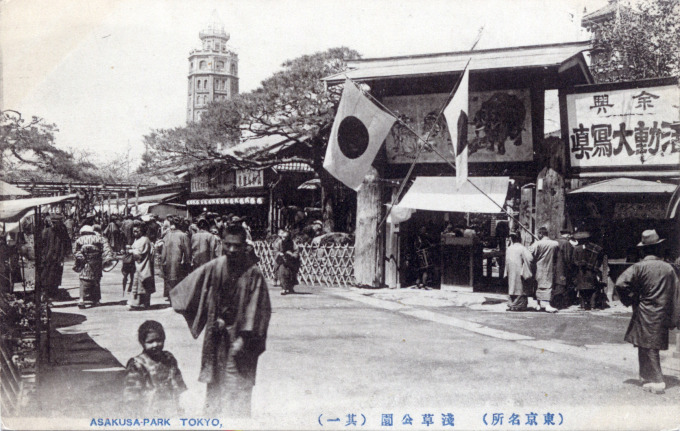
Entrance to Hanayashiki, at Asakusa Park, Tokyo, c. 1910. The Twelve-Storeys tower stands tall in the background.
“At the back of the Kannon temple there is a very spacious ground, which was turned into a public park in the 6th year of the present era Meiji, (1873).
“In it there are yokyu shops, or tea-houses where one can play with little bows and arrows, attended by young maids, jugglers, acrobats, theatres, photographic studio, etc., etc. Among these multitudinous shows, one will be pleased to visit the Hanayashiki, where there are to be seen various kinds of plants and flowers, birds and animals, and a large building in the Japanese style.
“By paying a small fee of admittance the visitor is admitted into the building, the floor of which is of fine mosaic work in wood, and the walls, posts, etc. are beautifully finished. The panorama, which represents the American civil war, the Ryoungaku, or Eiffel Tower of Asakusa, and Goju-no-To, the ancient pagoda may be visited. The ikiningyo, or life size images in wood, representing legends or historical anecdotes, may be curious to see, as some of them are moved by machines to perform some theatrical acts.
“Indeed the visitor can easily spend a day or two in visiting the manifold shows in the park.”
– The Imperial Hotel Guide Book and Map of Tokio, 1892
“Hanayahiki has operated since 1853. Once the Meiji era opened Japan up to the world, the little park lost its original elegant and formal nature, growing into a showplace for novelties and exhibitions. The park offered a curious public animal exhibits, acrobats, and the earliest motion pictures exhibited in Tokyo. Its identity as a fun fair may have begun with the addition of a merry-go-round. Throughout the Meiji era, it continued to amuse and amaze, tucked away between a couple of alleys adjacent to the Senso-ji temple and the Asakusa shrine. Its proximity to famed Senso-ji has made Hanayashiki a visible curiosity to shrine visitors and tourists, alike.
Map: Asakusa, showing the temple grounds (right and center), Hanayashiki (upper left), Asakusa Park (center-left), Theater Street (left), and Nakamise (lower right).
“In the post-WWII years, Hanayashiki has established itself as a popular (but small) amusement park, catering mostly to local families, especially those with young children. The park’s footprint has grown smaller, but new attractions have steadily been added, creating an unusual multi-layered effect, in which the park has had to grow vertically in order to expand.Many other regional and neighborhood amusement parks in Japan were shut down by the late nineties, but Hanayashiki has managed to carry on, however humbly, in its tiny corner of Tokyo.
“The very first roller coaster in Japan was erected in 1953 at Hanayashiki by TOGO. It is still in operation today.”
– Wikipedia


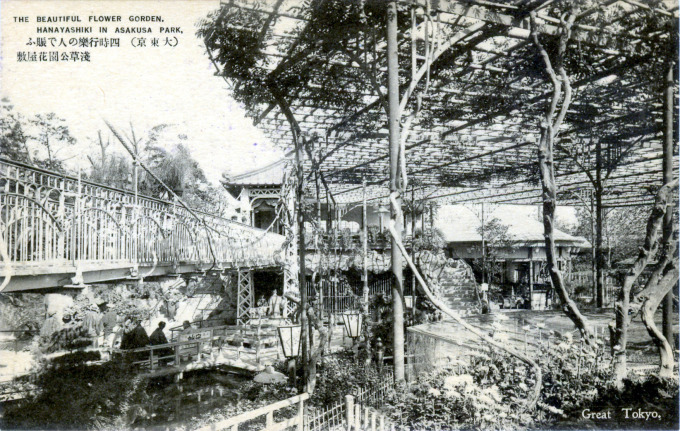
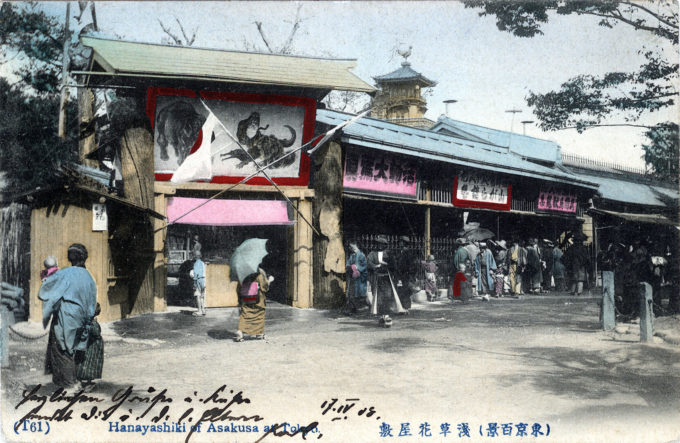
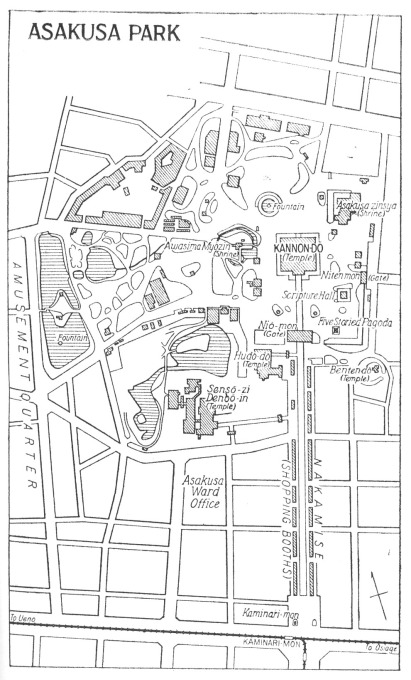
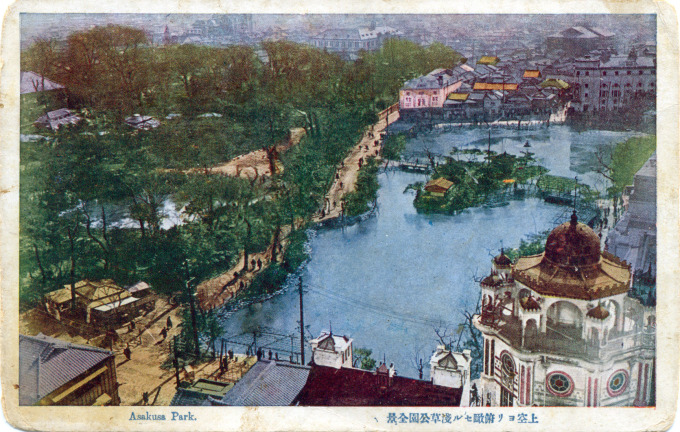
Pingback: Korakuen Amusement Park, c. 1960. | Old Tokyo
Pingback: Ferris Wheel at the Tokyo Industrial Exhibition, Tokyo, 1907 | Old Tokyo
Pingback: Asakusa Rokku (Theater Street), c. 1930. | Old Tokyo
Pingback: A Part of “Pleasure Land” at Asakusa Park, c. 1920. | Old Tokyo
Pingback: Asakusa Park, c. 1910. | Old Tokyo
Pingback: Asakusa Rokku (Theater Street), c. 1910-1950. | Old Tokyo